
Beipiaosaurus is a genus of therizinosauroid theropod dinosaur from the Early Cretaceous of China. Before the discovery of Yutyrannus, it was among the largest dinosaurs known from direct evidence to be feathered.

Scaphognathus was a pterosaur that lived around Germany during the Late Jurassic. It had a wingspan of 0.9 m (3 ft).
Yimenosaurus is an extinct genus of plateosaurid sauropodomorph dinosaur that lived in China in the Early Jurassic. The genus was first named in 1990 by Ziqi Bai, Jie Yang and Guohui Wang, along with its type and only species, Yimenosaurus youngi. The species name honours renowned Chinese paleontologist Yang Zhongjian, the father of Chinese paleontology, known as C.C. Young in English. Known material includes the holotype, an almost complete skull and mandible, as well as incomplete cervical and dorsal vertebrae, a mostly complete sacrum, an ilium, ischia, partial ribs and complete femur, and a paratype, a well-preserved postcrania with a fragmentary skull.

Pycnonemosaurus is a genus of carnivorous theropod dinosaur that belonged to the family Abelisauridae. It was found in the Upper Cretaceous Bauru-type red conglomerate sandstones of the Adamantina Formation, Mato Grosso, Brazil, and it lived about 70 million years ago during the Late Cretaceous.
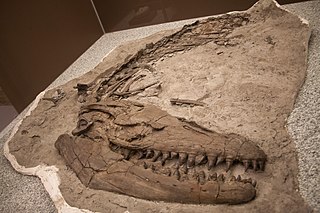
Prognathodon is an extinct genus of marine lizard belonging to the mosasaur family. It is classified as part of the Mosasaurinae subfamily, alongside genera like Mosasaurus and Clidastes. Prognathodon has been recovered from deposits ranging in age from the Campanian to the Maastrichtian in the Middle East, Europe and North America.
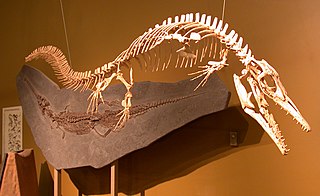
Halisaurus is an extinct genus of marine lizard belonging to the mosasaur family. The holotype, consisting of an angular and a basicranium fragment discovered near Hornerstown, New Jersey, already revealed a relatively unique combination of features and prompted a new genus to be described. It was named by Othniel Charles Marsh in 1869 and means "ocean lizard". It was renamed by Marsh to Baptosaurus in 1870, since he believed the name to already be preoccupied by the fish Halosaurus. According to modern rules, a difference of a letter is enough and the substitute name is unneeded, making "Baptosaurus" a junior synonym.
Judeasaurus is an extinct genus of small, aquatic varanoid lizard related to the mosasauroids. The only known specimen is from the Late Cretaceous of the Middle East, though its exact provenance is uncertain.
Terminonatator is a genus of elasmosaurid plesiosaur from the Late Cretaceous of Saskatchewan, Canada. It is known from a skull and partial skeleton from a young adult, found in the Campanian-age Bearpaw Formation near Notukeu Creek in Ponteix. Terminonatator is currently one of the youngest plesiosaurs from the Western Interior Seaway.
Cratochelone is an extinct genus of sea turtle in the family Protostegidae and containing a single species Cratochelone berneyi. The species is known only from the mid to late Albian Toolebuc Formation, part of the rolling downs group, in the Hughenden of Central northern Queensland, Australia.

Pseudopetalichthys problematica is a lightly armored pseudopetalichthyid placoderm from the Hunsrückschiefer Lagerstätte of Early Devonian Germany. The holotype and only known specimen is an articulated, but incomplete individual consisting of a large, mostly intact, plate-covered head, the bases of the pectoral fins, and most of the vertebral column, with a total length of 15 centimetres (6 in). The specimen superficially resembles Stensioella, though the structures of the mouth, and orbits, and placement of the gill rakers all differ.

Myrmeciites is an extinct form genus of bulldog ants in the subfamily Myrmeciinae of the family Formicidae, which contains three described species and two fossils not placed beyond the genus level. Described in 2006 from Ypresian stage deposits, all three of the described species and one unplaced fossil are from British Columbia, Canada, while the second unplaced fossil is from Washington State, USA. These ants were large, with the largest specimens collected reaching 3 centimetres (1.2 in). The behaviour of these ants would have been similar to extant Myrmeciinae ants, such as solitary foraging, nesting either in the soil or trees, and leaving no pheromone trail to food sources. Due to the poor preservation of these ants, their phylogenetic position among Myrmeciinae is unclear, and no type species has been designated. These ants are classified as incertae sedis in Myrmeciinae, but some writers have classified it as incertae sedis within the insect order Hymenoptera. This reclassification, however, has not been accepted; instead, Myrmeciites remains in Myrmeciinae.
Barreirosuchus is an extinct genus of trematochampsid notosuchian known from the Late Cretaceous of São Paulo State, southeastern Brazil. It contains a single species, Barreirosuchus franciscoi. It is most closely resembles Caririsuchus camposi from the Araripe Basin and Itasuchus jesuinoi also from the Bauru Basin, and shares with them several synapomorphies.

Deinodryinus? aptianus is an extinct species of Deinodryinus in the wasp family Dryinidae. The species is solely known from a Cretaceous fossil found in Mongolia.
Leninia is an extinct genus of basal ophthalmosaurine ichthyosaur known from the late Early Cretaceous of western Russia. Leninia was first named by Valentin Fischer, Maxim S. Arkhangelsky, Gleb N. Uspensky, Ilya M. Stenshin and Pascal Godefroit in 2013 and the type species is Leninia stellans. It was named for Vladimir Lenin, one of the leaders of the Communist Revolution in Russia, as the museum it is currently housed in is also named for him.
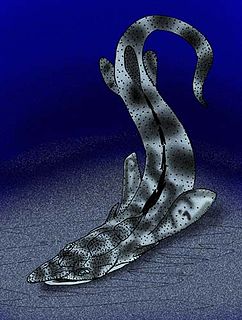
Nessariostoma granulosum is a lightly armored pseudopetalichthyid placoderm from the Hunsrückschiefer Lagerstätte of Early Devonian Germany. The type and only known specimen is an articulated, but very incomplete individual, deformed and elongated, consisting of a large, incomplete, tubercle-covered head, a long, beak-like rostrum, and some of the trunk, with a total length of 18 centimeters. N. granulosum was once placed in Stensioellida, though most other experts regard it at as a pseudopetalichthyid: Denison 1978 regards it as a placoderm incertae sedis because the specimen is deformed and so poorly preserved so as to stymie proper attempts at classification.

Diandongpetalichthys baojiaoshanensis is an extinct petalichthid placoderm from the Early Devonian of China.
Houornis is a genus of enantiornithean birds from the Jiufotang Formation of Liaoning, People's Republic of China. It is known from a single species, Houornis caudatus, which had been once been classified as a species of Cathayornis, and has also been regarded as a nomen dubium.
Eoprephasma is an extinct genus of stick insect in the superfamily Susumanioidea known from a group of Eocene fossils found in North America. When first described there was a single named species, E. hichensi.
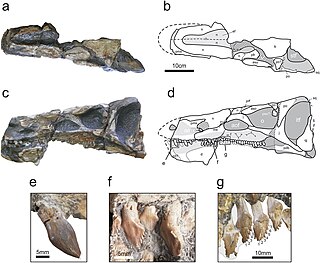
Isaberrysaura is a genus of ornithischian dinosaur from the Early Jurassic Los Molles Formation of Patagonia, Argentina. The genus contains a single species, I. mollensis, described by Salgado et al. in 2017 from a single specimen. Although initially classified as a basal neornithischian, subsequent analysis has allied it with the Stegosauria; the morphology of its skull resembles those of other members of the group.
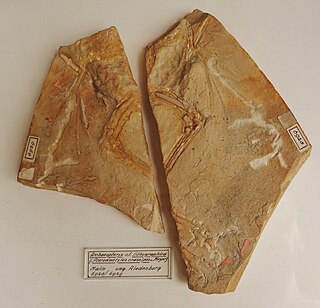
Ostromia is a genus of anchiornithid theropod dinosaur from the Late Jurassic Painten Formation of Germany. The genus contains a single species, O. crassipes, named by Christian Foth and Oliver Rauhut in 2017.




















